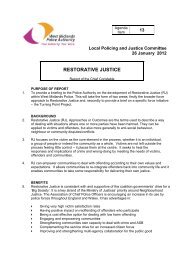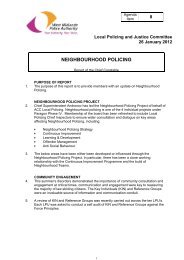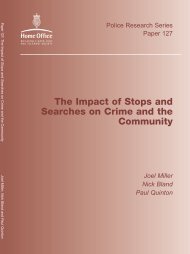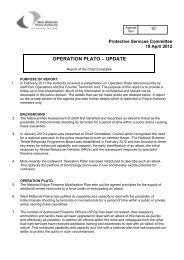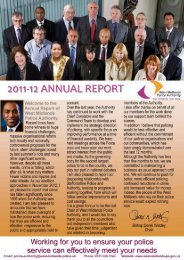regional collaboration update - West Midlands Police and Crime ...
regional collaboration update - West Midlands Police and Crime ...
regional collaboration update - West Midlands Police and Crime ...
You also want an ePaper? Increase the reach of your titles
YUMPU automatically turns print PDFs into web optimized ePapers that Google loves.
1<br />
Agenda<br />
Item<br />
10<br />
Finance <strong>and</strong> Resources Committee<br />
26 April 2012<br />
REGIONAL COLLABORATION UPDATE<br />
Report of the Chief Constable<br />
PURPOSE OF REPORT<br />
1. The purpose of this report is to <strong>update</strong> members on progress between <strong>West</strong> <strong>Midl<strong>and</strong>s</strong><br />
<strong>Police</strong> <strong>and</strong> Staffordshire <strong>Police</strong> in relation to collaborative approaches which have now<br />
been established <strong>and</strong> future opportunities currently being explored.<br />
BACKGROUND<br />
2. <strong>West</strong> <strong>Midl<strong>and</strong>s</strong> <strong>Police</strong> <strong>and</strong> Staffordshire <strong>Police</strong> have been seeking opportunities for<br />
collaborative approaches to specific elements of police services since 2010. Both<br />
forces recognise that collaborating over some services can provide cost <strong>and</strong> efficiency<br />
savings <strong>and</strong> an opportunity to provide a higher quality of service to the people in the<br />
force areas which they serve.<br />
COLLABORATION ACHIEVEMENTS<br />
3. Both forces have successfully collaborated on Legal Services which is now a single<br />
department shared between the 2 forces with a main office in Birmingham City Centre<br />
<strong>and</strong> a hub office in Staffordshire. This approach is expected to result in cost savings of<br />
£50,000 after the first full year of operation in comparison to the cost of both forces<br />
providing these functions independently. Furthermore, the collaborative arrangement<br />
will provide a greater resilience in terms of specialist staff availability <strong>and</strong> a more<br />
effective service to the courts in Staffordshire <strong>and</strong> the <strong>West</strong> <strong>Midl<strong>and</strong>s</strong> area.<br />
4. <strong>West</strong> <strong>Midl<strong>and</strong>s</strong> <strong>Police</strong> <strong>and</strong> Staffordshire are also collaborating in the sharing of ICT<br />
senior management. An arrangement has been in place for 1 year where the forces<br />
are sharing senior management staff in ICT.<br />
OPPORTUNITIES FOR COLLOBORATION<br />
5. Both forces are now seeking opportunities to collaborate in other areas including<br />
Uniformed Operations <strong>and</strong> Criminal Justice.<br />
6. Within Uniformed Operations both forces have broken down their services <strong>and</strong><br />
modelling of combined services has taken place with options for future service delivery<br />
produced. Threat <strong>and</strong> risk assessments have taken place <strong>and</strong> baseline costings have<br />
been produced. Colleagues in both locations have been consulted on the options for<br />
future service delivery. Options have been evaluated <strong>and</strong> a preferred option chosen<br />
within each area of business. A full business case will be produced for consideration<br />
by the Joint Committee for <strong>West</strong> <strong>Midl<strong>and</strong>s</strong> <strong>and</strong> Staffordshire <strong>Police</strong> Authorities on 2 nd<br />
May.<br />
7. The areas which are being reviewed to identify opportunities for collaboratively<br />
providing services within Uniformed Operations include Firearms operations, Firearms<br />
licensing, Dogs, Collision Investigation, Operational Support Units <strong>and</strong> the vehicle<br />
recovery scheme.
2<br />
8. Within Criminal Justice both forces have broken down their services to ensure<br />
that ‘criminal justice’ services are comparable for each force. The modeling of<br />
combined services has taken place to identify a series of options for future<br />
service delivery. These options are currently being evaluated <strong>and</strong> a preferred<br />
option identified. A full business case detailing the preferred option will be<br />
produced for presentation to the Joint Committee on 2 nd May.<br />
FINANCIAL IMPLICATIONS<br />
9. It has been agreed that business cases will be based on savings that can be<br />
achieved by both forces collaborating rather than an individual force on its own.<br />
Business cases will need to include set up <strong>and</strong> implementation costs, which may<br />
include redundancy where relevant. Each force will meet its own redundancy<br />
costs.<br />
10. The issue of cost sharing is complex given the different relative sizes of the two<br />
forces. This is compounded because each force has been undertaking cost<br />
reduction work separately <strong>and</strong> therefore has a different starting position in terms<br />
of the cost base <strong>and</strong> service provided.<br />
11. There is an attraction in having an agreed formula for cost or benefit sharing that<br />
is simple, equitable <strong>and</strong> able to be applied across a number of collaborative<br />
projects. An outline scheme has been developed based on sharing savings<br />
arising from <strong>collaboration</strong> in line with each force’s ‘shareholding’ ratio. This is<br />
calculated using the net cost of services <strong>and</strong> works out at 77% <strong>West</strong> <strong>Midl<strong>and</strong>s</strong>,<br />
23% Staffordshire.<br />
12. However, the merits of using a formulaic approach to benefit sharing need to be<br />
considered against a more pragmatic approach where the potential benefits<br />
profile does not easily lend itself to a formula distribution. For example, a saving<br />
resulting from a small number of management posts removed from a structure<br />
would be difficult to allocate on a formula basis, <strong>and</strong> it may be more sensible to<br />
allow cash savings to ‘lie where they fall’ <strong>and</strong> focus on the service delivery<br />
benefits instead. Alternatively, if larger cash savings were possible then both<br />
forces would want an equitable distribution <strong>and</strong> a formula would work well in that<br />
case.<br />
13. Any savings that arise from <strong>collaboration</strong> arrangements will assist with balancing<br />
the budget in the remaining CSR period.<br />
LEGAL IMPLICATIONS<br />
14. The legal implications within any collaborative approaches under consideration<br />
will be included in the business case produced for each area of business.<br />
EQUALITIES IMPLICATIONS<br />
15. The equalities implications within any collaborative approaches under<br />
consideration will be included in the business case produced for each area of<br />
business.
3<br />
RECOMMENDATIONS<br />
16. That the Authority note the content of this report.<br />
Chris Sims<br />
Chief Constable<br />
CONTACT OFFICER<br />
Name: Keith Trivett<br />
Title: Senior Accountant<br />
Tel: (0121) 626 5015 Lloyd House Ext: 7800 2656<br />
Email: k,trivett@west-midl<strong>and</strong>s.pnn.police.uk<br />
BACKGROUND CONTACT DOCUMENTS



